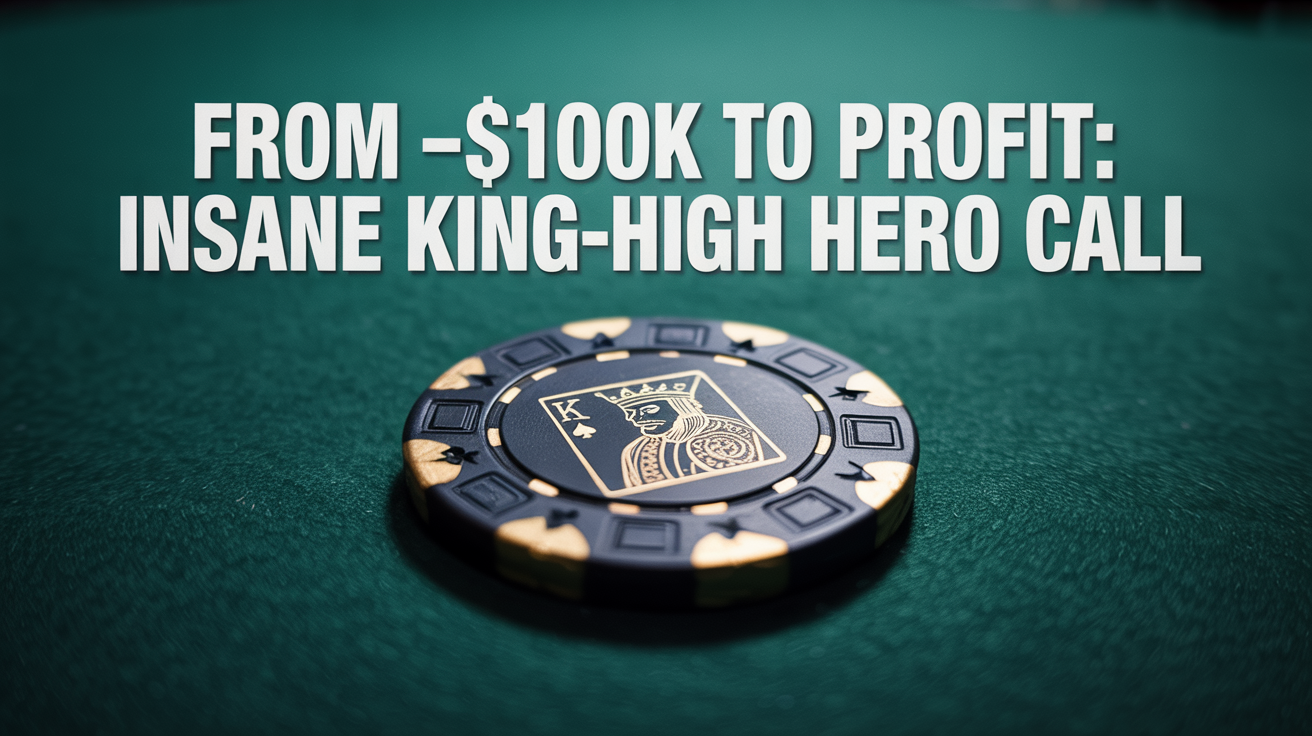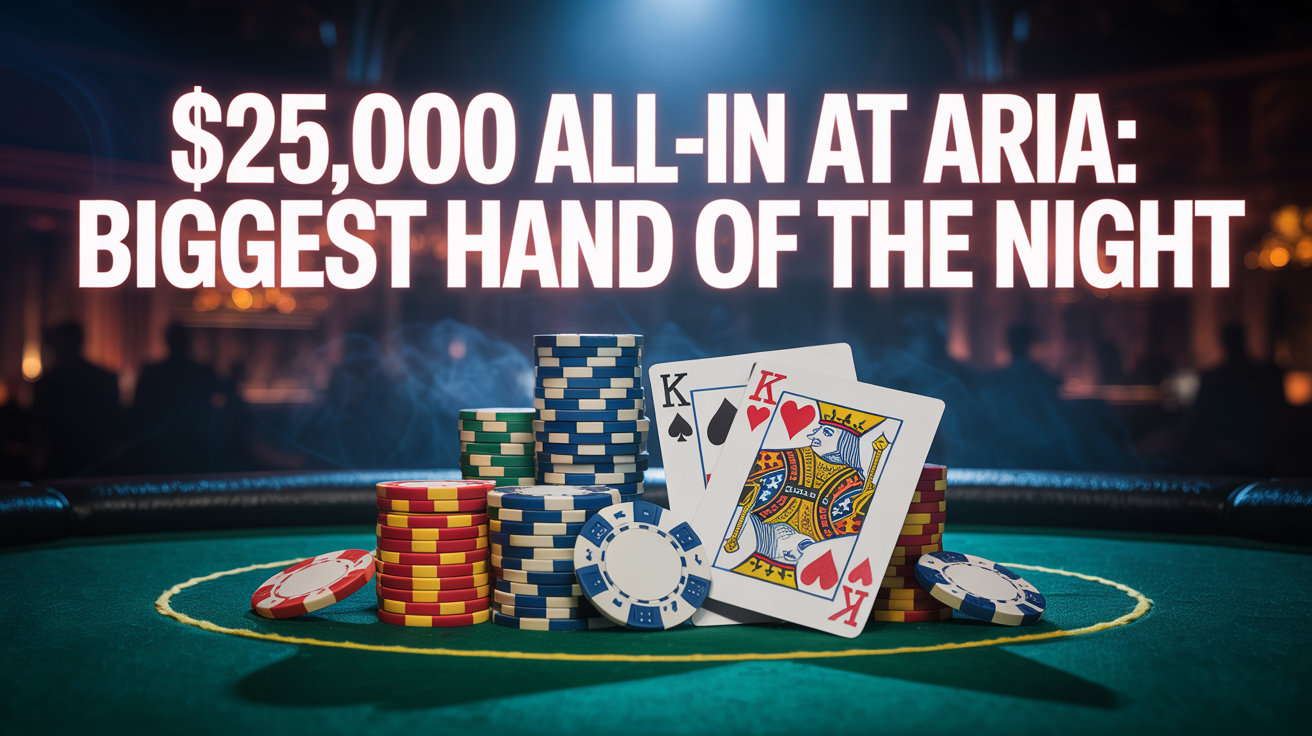The table is never quiet when Nik “Airball” sits down. Words whip around the felt, jokes volley between hands, and the tempo edges up until a single decision can tilt the whole room off its axis. The cache of hands in this session—sprawling, swingy, and thick with personality—reads like a field guide to modern high-stakes no-limit hold’em. It is a catalog of thin value and fat bluffs, of flip-for-a-house coin tosses and soul-squeezing folds, of live reads fighting solvers, of “run it twice?” compromises and “ship it” declarations. More than anything, it’s a story about pressure and how Airball applies it, absorbs it, and occasionally drowns in it—only to surface a few orbits later and start pressing again.
The Temperature Rises Before the First Showdown
Before chips truly fly, you can feel the table warming up through the chatter. There’s that quintessential live-poker philosophy debate about blocking the ace of clubs in a one-club board spot and whether the better bluffs should actually be the non-ace holdings. It’s a window into the way this table thinks: not as memorized charts, but as a lived blend of math, ego, and metagame. “You just spew some GTO Wizards,” someone ribs, and the room laughs because they all know this dance. They’ve studied the lines and they’ve broken them on purpose. Everyone is playing the players as much as the cards.
The cards, of course, cooperate quickly. “Aces for Stanley,” and the dial clicks a notch higher. Preflop sizing is not timid as stacks are deep and egos deeper. Airball calls, a flop falls in monochrome, and the commentary reminds us that on a board that pure, the suited ace matters more than a little. Tang counts out chips, a slick slow-play lurks, and the ritual of live poker unfolds: a question about coverage, an aside about bankrolls, and then the crisp phrase no one forgets—“All in.”
The indecision that follows is a live-poker classic. A player narrates his own thought process aloud, half for the table, half for himself. “I’m supposed to fold here, I guess.” Then the coin-flip logic of fate enters: a chip-randomizer call threshold, “nine to twelve I call,” the kind of theatrical flourish that both disarms and entices. It lands on call. The flush is shown. The pot goes the other way. The lesson is familiar but never gentle: in the biggest games, variance punishes hesitation, and then mocks you for learning.
Rick’s Furnace and the Price of Stoicism
If Airball is gasoline, Rick can be a furnace—steady, hot, and dangerous when fed. Their heads-up sequences are symphonies of pressure. A case eight on the flop, a bet of “twenty-five dimes,” the calm “Nicky calls,” and then the disaster card. When Rick barrels the turn and Airball responds by jamming “all infinite,” the table’s oxygen thins. Counting chips turns into counting consequences.
What’s remarkable here isn’t just the shove or the call; it’s the aftermath. Rick loses the kind of pot that would have most mortals making weather patterns out of chip stacks. Instead, he absorbs it with unshakable posture, pays, and continues. The commentary honors it out loud. There’s a secret truth to long-run winners in nosebleed games: the edge is often emotional. Tilt is a leak compound interest cannot ignore. Rick’s composure is not just character—it’s strategy.
Wheels, Traps, and the River That Ends It
Multiway pots are where true danger lives. An innocuous three peels on the turn. To some, a blank; to others, a disaster in waiting. The paradox of straights emerges—the pretty wheel that turns into a wreath when a bigger straight is possible. Santos feels the draw become a hand and then the hand shrink into a bluff-catcher. Airball sits on the bigger straight, the stone-cold nuts by the river, and chooses a sizing that is equal parts greed and insight. Into a pot just north of a hundred, he pushes almost two hundred—an amount that doesn’t beg to be called so much as it dares his opponent to insist on a chop that isn’t there. Santos pays, the table hums with that cocktail of admiration and dread, and the dealer’s quiet “nuts” punctuates the lesson. In the rarest moments, the cards give you the answer sheet. The job then is to write the entire essay in the bet size.
Kings, Deuces, and the Bridge of Nerves
Top pair collides with top pair on a board that refuses to run cleanly for anyone. Keating, tactile and theatrical with chips, massages stacks like a conductor warming up an orchestra. Airball connects hard—pair plus redraw—and the pot grows into a tense story about who dares to deny variance and who chooses to surf it. When the all-in lands and the reveal is unkind to Rick’s second-best hand, the result is less surprising than the feeling: inevitability in a game defined by surprises.
This is the invisible electricity of high stakes. For all the solver talk, for all the expected value calculations, there’s a human charge when an opponent’s hands hover over chips. The bridge of nerves between stacks is a live-wire. Even the best-prepared theory player must strap into the rollercoaster of outcomes he cannot script.
Diamonds Don’t Always Save You
Then there are the preflop train wrecks—the aces versus a live stack with a reason to gamble. Gaffrey is in the blender. He’s opened the good wine, tried to settle the night into something approachable, and instead walked into a wrecking ball. The money piles in pre, the agreement to run it twice is a nod to civility, and the deck, uninterested in treaties, bricks anyway. You can hear it in the table’s gallows humor: “Just one diamond,” a wish spoken like a parlor trick. The river gives none. The buy-ins don’t care about narrative symmetry.
Airball, for his part, plays the emotional math as well as the pot odds. He moves calmly into the next hand, as if variance is a roommates’ argument rather than a home invasion. It’s not indifference; it’s a cultivated amnesia. You cannot hold onto previous pain and still find the courage to value-bet thinly or pull the trigger on the next polarized shove.
When Cowboys Ride into a Buzzsaw
Ace-king against kings is a pop quiz that even great players fail by no fault of their own. Roble, capable and deceptively quiet, builds a preflop cage with a three-bet that telegraphs strength without blinking. Airball, holding the broadway cannon, recognizes that the dynamic favors aggression and chooses the path of maximum variance. The chips go in. The count is enormous. They haggle over how many boards to run like surgeons discussing anesthesia.
There’s a poetic cruelty to the way the boards peel off. One board props up Roble with hope; the other betrays him. There’s a half-breath where hearts might chop, where a jack might rescue, where the expected value feels less like a number and more like a prayer. It doesn’t land. Scooped again. The table’s soundtrack becomes a muted empathy. A week ago a similar pile of chips went the other way against another opponent. The echo is unmistakable. In this room, short-term justice is a rumor.
The Cold Splash of Aces into an Avalanche
A different configuration, same violence. Gaffrey has aces and does what aces demand: denies equity with a sizing that announces intent. Airball wakes up with ace-king once more and refuses to be a passenger. He jams. The call is mandatory. Twice again, for mercy and for math. The deck sketches a straight draw for Airball on the first runout—hope enough to keep the air thin—and then denies the miracle. The second board ends quickly, clinically. In the span of three minutes, nearly a quarter million changes address, and the night wears a new expression.
The commentary gives Gaffrey his flowers. He has weathered rough starts and found his footing, which is not just a narrative arc but a poker skill. Every regular who lasts in these games learns to treat sessions like single pages, not whole novels. One chapter ends with aces holding. Another will not be so neat.
The Flush Trap and the Cost of Being Second Best
Some of the most expensive lessons in no-limit hold’em are printed on monotone boards. Airball picks up spades on the turn; Peter already owns them heavier. Kiki is the fuse-lighter between them, betting into two hands that dwarf his own and triggering the real decisions. Airball, with the king-high flush, is precisely where very good hands go to die against absolute bests. Peter, with the nut flush and the jack accompanying like a parade marshal, chooses pressure rather than patience and raises to a number that makes everyone in the room do mental long division.
Airball’s call is not reckless; it’s consistent with stacked ranges and real-world frequencies. But here, reality bites. The river does nothing to break the trap, and Peter rakes. The pot is a public service announcement no one wants to watch: in the deepest waters, top-tier second-best hands are not consolation prizes—they are liabilities.
Tens Against Ace-King and the Coin Toss that Defines a Season
There’s a pure, almost nostalgic feel to tens versus ace-king. The room leans in not because the solver has something new to say but because the outcome carves out the rest of the night’s plot. Rick four-bets to a number that says he’s ready to play for stacks. Airball looks down at two tens, the kind of hand that is both a fist and a question mark, and answers with an all-in that honors the aggression. The runouts, plural, serve drama like a tasting menu: a board that gives Rick hope without salvation, then a set for Airball, and then a tally that says it all—back-to-back flopped sets at the biggest stakes on television.
The table notices not just the luck but the looseness of fate. Is Airball playing better this season? The commentary floats the thesis. It’s not a statistical claim; it’s a vibe. Tighter in bad spots, looser in profitable ones, more precise with rivers, less stubborn in the margins. In games where edges are shaved thinner than cards, small calibrations feel like revolutions.
Santos Versus the Avalanche
If you spend enough time in these rooms, you are Santos eventually—priced in, pot-committed by logic and ego, facing the one opponent you would have preferred to trap rather than tangle with. Preflop grows to one hundred thousand almost by reflex. You can hear it in the cadence: “Already, we’re over two hundred grand in the middle.” The flop drags Santos’ hand forward into the daylight. Airball’s continuation stabs are not mere stabs; they are surgical incisions into capped ranges. The turn fails to rescue, and the shove arrives like a verdict.
Running it twice is charity to the psyche. It doesn’t alter the time signature of the moment: nearly a million in play, and the first board is a coin flipped on its edge. When it topples, it topples for Airball, and the second follows suit. The table exhales. Santos’ stack shrinks in a way that changes how every subsequent hand will be played. Invisible chips move from theoretical future bluffs to retired possibilities. That’s the undersold reality of nine-hundred-thousand-dollar pots: they reprice the whole evening’s menu.
Language, Metagame, and the Theater of Information
A large part of this session’s magnetism isn’t the chips; it’s the conversation. Players talk about blockers and the advisability of bluffing without the ace of clubs in club-heavy textures, about whether slow-playing on paired flops hides strength or exposes it, about whether a shove is “GTO” or “monkey tilt.” It’s not empty table talk. It’s real-time metagame warfare. Airball contributes as much with tone as with tactics. A flippant aside can harden an opponent’s calling frequency; a sigh can crack it. The “randomizer” performance is not just drama—it’s disinformation, the live equivalent of encrypted RNG. If a player feels he watched you randomize, he might forgive a thin call that would otherwise shame him, or he might call more often because he believes you care about frequencies more than exploitative adjustments. In the cracks of those reactions is where profit lives.
Bet Sizing as Storytelling
The best hands in this session are masterclasses in telling and breaking stories with numbers. The two-hundred-into-one-oh-eight river bet with the nuts is not a blunt instrument; it’s a sculpted sentence that names a villain only your opponent can see. Against a six, it is a taunt. Against two pair, it is a morality play. Against a chop, it is a riddle. Against air, it is a dare no one takes. That is what elite live no-limit is: arranging dollars into shapes that force the other person to finish your story the way you want it to end.
The same is true on the other end. When Peter chooses a raise size on the flush board that gives Airball a “sick” decision instead of a trivial fold or snap call, he is not just maximizing EV in a vacuum; he’s pulling on the elastic band of pain tolerance and hero-calling pride. Good players choose profitable sizes. Great players choose profitable sizes that specifically torment that opponent on that day.
Running It Twice, Living It Once
One of the session’s recurring drumbeats is the bargain to run it twice. It divides agony and shuffles equity around the edges, but it doesn’t change the evening’s essential truth: each player sleeps with only one result. In that sense, running twice is a poker koan. You watch the same hand be both victory and defeat and then you live with the aggregate. Airball seems built for this kind of cognitive dissonance. When he wins the first and removes that “load off,” you can see him reset physically—shoulders settle, eyes refocus. It’s more than superstition. It’s a performance hack. Players in these games must engineer their own emotional volatility dampeners. Running twice is only one button on that panel.
The Culture of Respect and the Economics of Ego
High Stakes Poker is a spectacle, but it’s also a workplace. People clock in and out with millions at risk and reputations leveraged against the audience’s memory. The teasing is affectionate, and the praise, when offered—“He takes losing incredibly well”—carries more weight than any endorsement. There’s a code here that has nothing to do with etiquette and everything to do with longevity. You tip the dealer and you tip the table with composure. If you cannot lose without poisoning the room, the room will spit you out. If you cannot win without humiliating the man across from you, the invitations will dry up. Airball walks that tightrope with showman’s balance. He needles with a smile, boasts with a wink, then dials up the pressure again.
Tilt as a Character and the Art of Containing It
“Monkey tilt” gets tossed around like a nickname, but it’s a genuine villain in this story. The transcript even plays with recursive awareness: “I know that you know that I know.” This is how modern poker speaks about tilt now—not as an on/off switch, but as a feedback loop between identity and strategy. Airball flirts with that edge frequently. If he barrels one too many turns or calls one too many river raises, it’s not because he forgot the math; it’s because he’s testing the scaffolding of his own composure.
What sets him apart in this session is the rate at which he recovers. The hands after the setbacks do not look like apology poker. They look like adjusted poker. Fold frequencies snap back. Value bets stay thin. He still finds the river overbet with the nuts, still folds the capped marginal in the right spot, still chooses jam instead of call when it is the profitable discomfort. That is the hidden stat great live pros carry: tilt half-life.
Airball’s Arc Across the Session
By the time the final big pots have rung the bell, a pattern emerges. Airball is not merely running hot or cold; he is surfing the variance by making better choices at its peaks. He wins mammoth all-ins and loses others, but within those flips and coolers is a higher-order consistency: he attacks capped ranges, widens when he holds coverage, narrows when his blockers betray him, and chooses aggressive lines when there’s enough fold equity to justify the carnage.
If he is indeed “playing better this season,” it’s not because the deck chose him. It’s because he’s letting it choose him less. He’s constraining the places where luck can hurt him most and opening the valves where it can help him without risking catastrophe. That may sound like mysticism, but it’s very practical. A player can decide to three-bet slightly less often from small blind against a particular under-the-gun who refuses to fold to four-bets. He can decide to overbet brick rivers in flooding runouts against middle-pair stations. He can decide to call fewer turn check-raises from that one opponent who only has it. Over an evening, those micro-edits add up to a macro impression: better.
The Hands We Remember and the Hands We Forget
We will all remember the almost-million-dollar collision with Santos, the flush-over-flush where Peter raised to the rafters, the aces versus ace-king preflop pile-ins, and the coolers that sounded like thunderstorms. But the true story of Airball in this session lives in the quieter beats: the fold that didn’t make the highlight reel, the delayed c-bet that trapped a second-best hand inside its own optimism, the fast call that denied a bluffer his showbusiness. Television edits cannot dwell there, but bankrolls do.
Poker at these limits is a biography written one decision at a time. Airball’s chapter here isn’t about invincibility or inevitability; it’s about pressure literacy. He reads pressure well, writes it better, and recites it back to opponents until they forget their lines.
Why It Matters Beyond the Show
Sessions like this are more than entertainment. They’re case studies for anyone trying to move from good to dangerous in no-limit hold’em. They show how bet sizing can function as language, how run-it-twice etiquette can become strategic, how table talk serves as both camouflage and sonar, how stoicism pays dividends, and how even world-class players can be coaxed into bad calls by numbers that feel like insults rather than prices.
Most of all, they remind us that poker is not the cards. It’s the story players tell about the cards in real time, with money as punctuation. Airball’s story on this night is not tidy, but it’s compelling. He bluffs in places that demand backbone, value-bets with audacity, and folds when ego begs him not to. He lands the greedy river with the nuts, he tumbles into the flush trap others set, he flips for stacks as if variance were a business expense. And he keeps talking—not to distract from the work, but as part of it.
Final Image: The Quiet After the Rake
After the largest pots, there is always a strange silence. Chips are counted, pushed, stacked. Someone sighs. Someone jokes. The dealer shuffles quickly, eager to launder the table of its last hand. Airball looks the same as he did an hour ago: alert, a grin always half-cocked, a sentence forever half-finished. The table knows he’ll be in the very next pot that matters. That is his nature, and at these stakes, nature is destiny.
The session closes without a sermon. No single hand teaches everything; no single result explains a career. But the collage does. If you watched closely, you didn’t just see Nik Airball win and lose hundreds of thousands. You saw a craftsman shape pressure with his hands. You saw bet sizes used like verbs, runouts read like weather reports, and opponents treated as characters instead of statistics. You saw the delicate balance between frequency and feeling, between theory’s permission and instinct’s command.
And you saw, again, why people keep taking seats in games they could just as easily rail: because on nights like this, when the biggest pots crackle and the room laughs in the middle of a storm, poker is not merely a contest. It is live theater. And Nik Airball, love him or loathe him, knows exactly how to keep the audience from looking away.






